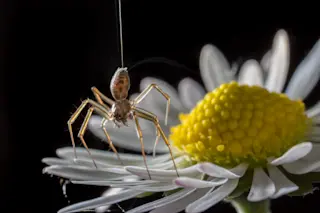Spiders "tiptoe" to release silk into the air before ballooning away. (Credit: Michael Hutchinson/naturepl.com)Spidey-senses tingling? It’s time to fly. Though those of us without arachnid superpowers might not notice, we are constantly surrounded by electric fields. The ground carries a slight negative charge and the atmosphere is slightly positive, and, as a consequence, negatively charged particles can be borne up into the air. Some kinds of spiders may be taking advantage of the effect to hitch rides on the fields using negatively charged spider silk as an electric buoy to get as high as two and a half miles in the air.Sensory biologist Erica Morley found that Erigone spiders can sense the electric fields that naturally occur in Earth’s atmosphere. They use the information to guide airborne voyages that can go for hundreds of miles, suspended from wisps of silk that act as sails, in a process scientists have playfully ...
Go Web, Go! Spiders May Use Silk to Sail On Electric Fields
Discover how ballooning spiders use electric fields for flight, thanks to their unique silk and sensory hairs. A fascinating read!
More on Discover
Stay Curious
SubscribeTo The Magazine
Save up to 40% off the cover price when you subscribe to Discover magazine.
Subscribe













